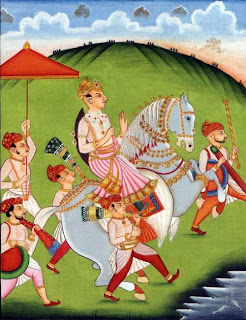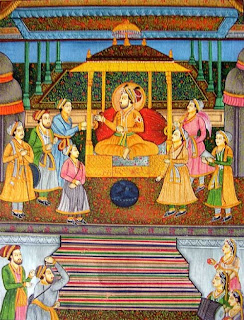 Despite great differences in particular
details of style and presentation, the princely portraits and paintings of
animals found in the Green collection reveal that visual specificity was but
one of the artists' concerns. The works created for Rajput and Mughal patrons
are carefully composed images, intended to convey particular kinds of
information about the subject. Of greater concern than specific physiognomic
details in a portrait might be the underscoring of the subject's status through
a particular manner of presentation and the depiction of certain accoutrements.
Such paintings were, in part, meant to fulfill functions not altogether
different from the promotional material created by today's PR agents. Thus, as
is true for princely imagery rendered at courts throughout the world, the
motivations behind the particular character of many Rajput and Mughal paintings
likely included a desire to project very calculated images of a ruler and his
realm.
Despite great differences in particular
details of style and presentation, the princely portraits and paintings of
animals found in the Green collection reveal that visual specificity was but
one of the artists' concerns. The works created for Rajput and Mughal patrons
are carefully composed images, intended to convey particular kinds of
information about the subject. Of greater concern than specific physiognomic
details in a portrait might be the underscoring of the subject's status through
a particular manner of presentation and the depiction of certain accoutrements.
Such paintings were, in part, meant to fulfill functions not altogether
different from the promotional material created by today's PR agents. Thus, as
is true for princely imagery rendered at courts throughout the world, the
motivations behind the particular character of many Rajput and Mughal paintings
likely included a desire to project very calculated images of a ruler and his
realm.
Mughal and Rajput patrons were extremely
interested in paintings with courtly themes as these works reflected the world
in which they lived. Portrayals of princely life first achieved prominence in
Indian painting under Mughal patronage and subsequently became an important
aspect of Raj put imagery as well. Such paintings in the Green collection
include aristocratic male portraits and depictions of animals, for horses and
elephants, as well as more exotic specimens, were often highly prized by their
royal owners.
Among the manuscripts that the Mughal
emperor Akbar commissioned were a number of superbly illustrated histories of
his illustrious forbears—who included Chingiz (Genghis) Khan and Timur
(Tamerlane)—and of his own noteworthy reign as well as many individual
portraits. Indeed, a large portion of the production of the early Mughal
painting workshop was devoted to the depiction of courtly themes. An interest
in such themes was, in part, influenced by long-established Iranian traditions
of depicting royal persons and activities, such as princely figures engaged in
hunts or refined pursuits such as reading. Also influential were Western art
traditions, especially that of portraiture, introduced into the Mughal court in
the late sixteenth century. It was, how-ever, the keen interest of Akbar and
other Mughal rulers in images that reflected their particular sense of the
world around them that is most directly responsible for the popularity of
themes of courtly life and portraiture found in Mughal painting.
Before the
establishment of the Mughal dynasty there were no directly observed,
individualized portrayals in India, although certainly an interest in such
portraiture existed, as is demonstrated by written sources. Early Mughal portraiture
seems to have been unusual enough that Akbar's chief historian, Abul Fazl, was
compelled to record that not only did the emperor sit for his portrait, but he
also ordered the likenesses of all the grandees in the realm be painted. An
immense album of portraits was thus formed, and as Abul FazI notes, "Those
that have passed away have received new life and those who are still alive have
immortality promised them". Akbar and his descendants likely recognized
the value of such images in their evaluation of the character of the many
individuals involved in the administration of their immense realm as well as
their use in glorifying their own dynasty.
Individual
paintings eventually superseded the popularity of illustrated historical and
literary texts at the Mughal court as fewer and fewer such manuscripts were
commissioned. Favored instead were albums in which single paintings of various
subjects were combined with pages of beautifully calligraphed passages. Such
albums first became popular in the early seventeenth century during the reign
of the Mughal emperor Jahangir. Portraits and scenes of princely activities
were common subjects, as were floral and animal studies. Such paintings
continued to be rendered throughout the subsequent history of Mughal art.
Several works in the Green collection exemplify the type of portraits and
animal studies frequently made for Mughal patrons.
For Rajput patrons too, images of
themselves and the world in which they lived were extremely important. Even
though the interest in paintings with religious or literary subjects never
waned, a significant concern of many painters working for various Raj put
patrons was portraying the glorious person as of these rulers. Portraits
executed at the Raj put courts were at first largely inspired by Mughal
practice. One particularly early work in the Green collection, which dates from
the first part of the seventeenth century, is a clear demonstration of this
influence. In the eighteenth century a shift occurred at many Rajput courts
toward producing more portraits, and such works continued to be favored until
the decline of Rajput patronage of painting in the second half of the
nineteenth century.
Although influential, Mughal models were
freely adapted and transformed by Rajput artists. Indeed, even though many
specific Mughal elements made their way into Raj put schools, Raj put portraits
and depictions of princely pursuits also benefited from previously established
Indian traditions. Often a greater interest of Raj put painters in the inner
essence of their subjects rather than a faithful reproduction of their outward
appearance resulted in images of selective reality. Paintings in the Green
collection, such as an elegant rendering of royal worshippers and a powerful
but highly stylized portrayal of the Kota ruler Chattur Sal, demonstrate some
of the different ways in which Raj put painters departed from Mughal models.
However, neither Mughal nor Rajput paintings generally depict women with the
same specificity as male subjects. Females were largely defined by their roles
and were not usually distinguished as specific personalities but were instead
portrayed as ideal types.
In addition to portraits, other princely
subjects, such as elaborate festivals, entertainments, and hunts, were
frequently depicted by Raj put artists. Although these are subjects also
encountered in Mughal works, paintings such as a Basohli elephant combat and a
Kota hunt scene demonstrate the brilliant inventiveness to be found in the Raj
put expressions of these already established princely themes. Individual
depictions of courtiers, a popular Mughal theme, rarely seem to have been
painted by Raj put artists. Also unlike the Mughal tradition, historical scenes
were generally not as favored by Raj put patrons. A number of posthumously
executed portraits, however, reveals a similar interest in one's forbears.
Examples of this practice in the Green collection include posthumous portrayals
of the renowned rulers Sidh Sen of Mandi and Ajit Singh of Jodhpur. Such works
suggest that an awareness and promotion of the prestige of royal lineages was
also a concern of the Rajput courts.
 Despite great differences in particular
details of style and presentation, the princely portraits and paintings of
animals found in the Green collection reveal that visual specificity was but
one of the artists' concerns. The works created for Rajput and Mughal patrons
are carefully composed images, intended to convey particular kinds of
information about the subject. Of greater concern than specific physiognomic
details in a portrait might be the underscoring of the subject's status through
a particular manner of presentation and the depiction of certain accoutrements.
Such paintings were, in part, meant to fulfill functions not altogether
different from the promotional material created by today's PR agents. Thus, as
is true for princely imagery rendered at courts throughout the world, the
motivations behind the particular character of many Rajput and Mughal paintings
likely included a desire to project very calculated images of a ruler and his
realm.
Despite great differences in particular
details of style and presentation, the princely portraits and paintings of
animals found in the Green collection reveal that visual specificity was but
one of the artists' concerns. The works created for Rajput and Mughal patrons
are carefully composed images, intended to convey particular kinds of
information about the subject. Of greater concern than specific physiognomic
details in a portrait might be the underscoring of the subject's status through
a particular manner of presentation and the depiction of certain accoutrements.
Such paintings were, in part, meant to fulfill functions not altogether
different from the promotional material created by today's PR agents. Thus, as
is true for princely imagery rendered at courts throughout the world, the
motivations behind the particular character of many Rajput and Mughal paintings
likely included a desire to project very calculated images of a ruler and his
realm.
Subscribe to:
Post Comments (Atom)














0 Response to "Courtly Themes"
Post a Comment